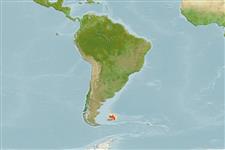Preferred temperature (Ref.
123201): 3.9 - 6, mean 4.6 °C (based on 27 cells).
Phylogenetic diversity index (Ref.
82804): PD
50 = 0.5000 [Uniqueness, from 0.5 = low to 2.0 = high].
Bayesian length-weight: a=0.00513 (0.00253 - 0.01042), b=3.12 (2.95 - 3.29), in cm total length, based on LWR estimates for this Genus-body shape (Ref.
93245).
ระดับชั้นอาหาร (Ref.
69278): 4.0 ±0.7 se; based on size and trophs of closest relatives
ความสามารถในการกลับคืนสู่ปกติ (Ref.
120179): ต่ำ, เวลาต่ำสุดที่จะทำให้ประชากรเพิ่มขึ้นเป็น 2 เท่าใช้เวลา 4.5 - 14 ปี (Fec assumed to be <100).
Fishing Vulnerability (Ref.
59153): High to very high vulnerability (67 of 100).
Nutrients (Ref.
124155): Calcium = 4.32 [0.65, 78.93] mg/100g; Iron = 0.242 [0.023, 2.796] mg/100g; Protein = 14.9 [13.3, 16.7] %; Omega3 = 0.677 [0.259, 1.711] g/100g; Selenium = 15 [3, 70] μg/100g; VitaminA = 9.8 [0.8, 124.4] μg/100g; Zinc = 0.296 [0.020, 3.302] mg/100g (wet weight); based on
nutrient studies. 